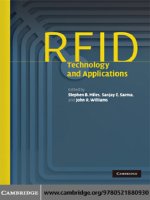solar cell technology and applications
Bạn đang xem bản rút gọn của tài liệu. Xem và tải ngay bản đầy đủ của tài liệu tại đây (5.9 MB, 308 trang )
Solar Cell
Technology and
Applications
Advances in Semantic Media Adaptation and
Personalization, Volume 2
Marios Angelides
ISBN: 978-1-4200-7664-6
Architecting Secure Software Systems
Manish Chaitanya and Asoke Talukder
ISBN: 978-1-4200-8784-0
Architecting Software Intensive Systems:
A Practitioners Guide
Anthony Lattanze
ISBN: 978-1-4200-4569-7
Business Resumption Planning, Second Edition
Leo Wrobel
ISBN: 978-0-8493-1459-9
Converging NGN Wireline and Mobile
3G Networks with IMS: Converging NGN
and 3G Mobile
Rebecca Copeland
ISBN: 978-0-8493-9250-4
Delivering Successful Projects with TSP
SM
and Six Sigma: A Practical Guide to
Implementing Team Software Process
SM
Mukesh Jain
ISBN: 978-1-4200-6143-7
Designing Complex Systems: Foundations of
Design in the Functional Domain
Erik Aslaksen
ISBN: 978-1-4200-8753-6
The Effective CIO: How to Achieve Outstanding
Success through Strategic Alignment, Financial
Management, and IT Governance
Eric Brown and William Yarberry, Jr.
ISBN: 978-1-4200-6460-5
Enterprise Systems Backup and Recovery:
A Corporate Insurance Policy
Preston Guise
ISBN: 978-1-4200-7639-4
Essential Software Testing: A Use-Case
Approach
Greg Fournier
ISBN: 978-1-4200-8981-3
The Green and Virtual Data Center
Greg Schulz
ISBN: 978-1-4200-8666-9
How to Complete a Risk Assessment in 5 Days
or Less
Thomas Peltier
ISBN: 978-1-4200-6275-5
HOWTO Secure and Audit Oracle 10g and 11g
Ron Ben-Natan
ISBN: 978-1-4200-8412-2
Information Security Management Metrics:
A Definitive Guide to Effective Security
Monitoring and Measurement
W. Krag Brotby
ISBN: 978-1-4200-5285-5
Information Technology Control and Audit,
Third Edition
Sandra Senft and Frederick Gallegos
ISBN: 978-1-4200-6550-3
Introduction to Communications Technologies:
A Guide for Non-Engineers, Second Edition
Stephan Jones, Ron Kovac, and Frank M. Groom
ISBN: 978-1-4200-4684-7
IT Auditing and Sarbanes-Oxley Compliance:
Key Strategies for Business Improvement
Dimitris Chorafas
ISBN: 978-1-4200-8617-1
The Method Framework for Engineering System
Architectures
Peter Capell, DeWitt T. Latimer IV, Charles
Hammons, Donald Firesmith, Tom Merendino,
and Dietrich Falkenthal
ISBN: 978-1-4200-8575-4
Network Design for IP Convergence
Yezid Donoso
ISBN: 978-1-4200-6750-7
Profiling Hackers: The Science of Criminal
Profiling as Applied to the World of Hacking
Raoul Chiesa, Stefania Ducci, and Silvio Ciappi
ISBN: 978-1-4200-8693-5
Project Management Recipes for Success
Guy L. De Furia
ISBN: 9781420078244
Requirements Engineering for Software and
Systems
Phillip A. Laplante
ISBN: 978-1-4200-6467-4
Security in an IPv6 Environment
Jake Kouns and Daniel Minoli
ISBN: 978-1-4200-9229-5
Security Software Development: Assessing and
Managing Security Risks
Douglas Ashbaugh
ISBN: 978-1-4200-6380-6
Software Testing and Continuous Quality
Improvement, Third Edition
William Lewis
ISBN: 978-1-4200-8073-5
VMware Certified Professional Test Prep
John Ilgenfritz and Merle Ilgenfritz
ISBN: 9781420065992
OTHER AUERBACH PUBLICATIONS
Solar Cell
Technology and
Applications
A.R. Jha, Ph.D.
Auerbach Publications
Taylor & Francis Group
6000 Broken Sound Parkway NW, Suite 300
Boca Raton, FL 33487-2742
© 2010 by Taylor and Francis Group, LLC
Auerbach Publications is an imprint of Taylor & Francis Group, an Informa business
No claim to original U.S. Government works
Printed in the United States of America on acid-free paper
10 9 8 7 6 5 4 3 2 1
International Standard Book Number: 978-1-4200-8177-0 (Hardback)
This book contains information obtained from authentic and highly regarded sources. Reasonable efforts
have been made to publish reliable data and information, but the author and publisher cannot assume
responsibility for the validity of all materials or the consequences of their use. The authors and publishers
have attempted to trace the copyright holders of all material reproduced in this publication and apologize to
copyright holders if permission to publish in this form has not been obtained. If any copyright material has
not been acknowledged please write and let us know so we may rectify in any future reprint.
Except as permitted under U.S. Copyright Law, no part of this book may be reprinted, reproduced, transmit-
ted, or utilized in any form by any electronic, mechanical, or other means, now known or hereafter invented,
including photocopying, microfilming, and recording, or in any information storage or retrieval system,
without written permission from the publishers.
For permission to photocopy or use material electronically from this work, please access www.copyright.
com ( or contact the Copyright Clearance Center, Inc. (CCC), 222 Rosewood
Drive, Danvers, MA 01923, 978-750-8400. CCC is a not-for-profit organization that provides licenses and
registration for a variety of users. For organizations that have been granted a photocopy license by the CCC,
a separate system of payment has been arranged.
Trademark Notice: Product or corporate names may be trademarks or registered trademarks, and are used
only for identification and explanation without intent to infringe.
Library of Congress Cataloging‑in‑Publication Data
Jha, A. R.
Solar cell technology and applications / A.R. Jha.
p. cm.
Includes bibliographical references and index.
ISBN 978-1-4200-8177-0 (alk. paper)
1. Solar cells. 2. Photovoltaic power systems. 3. Solar batteries. I. Title.
TK2960.J54 2010
621.31’244 dc22 2009020578
Visit the Taylor & Francis Web site at
and the Auerbach Web site at
rbach‑publications.com
is book is dedicated to my beloved parents who always encouraged
me to pursue advanced research and development activities in the
fields of science and technology for the benefit of mankind.
vii
Contents
Preface xvii
1 Chronological History and Scientific Advancements in the
Development of Solar Cell Technology 1
1.1 Introduction 1
1.1.1 Chronological History of Developmental and
Photovoltaic Power Generation Schemes Worldwide 2
1.1.2 Why Solar Energy? 4
1.2 Identification of Critical Parameters and Design Aspects of a
Silicon Solar Cell 4
1.3 Applications of Solar Power Systems 6
1.3.1 Solar Power Sources for Homes and Commercial
Buildings 7
1.3.1.1 Corporate Rooftops Using High Capacity
Solar Energy Systems 8
1.3.1.2 Solar Module and Panel Installation
Requirements 9
1.3.1.3 Impact of State and Federal Tax Rebates and
Incentives 10
1.3.1.4 Photovoltaic (PV) Installation Capacity
Worldwide 11
1.3.1.5 Factors Impacting Solar Panel Installations 12
1.3.2 Photovoltaic Solar Energy Converters for Space
Applications 13
1.3.3 Radio Relay Stations 15
1.3.4 Navigation Aid Sensors 15
1.3.5 Railroad Communications Networks 16
1.3.6 Educational TV Programs 17
1.3.7 Optimization of Solar Electric System for Specific
Applications 17
viii ◾ Contents
1.4 Fabrication Materials for Solar Cells and Panels 19
1.4.1 Crystalline Silicon Solar Cells 19
1.4.2 Fabrication of a-Si in-Film Solar Cells Using Laser
Scribing 22
1.4.3 Automated In-Line Processing for in-Film Solar
Cells 22
1.4.4 in-Film Photovoltaic Market Growth 23
1.5 Concentrated Solar Technology 25
1.5.1 Collaboration Key to Successful Entrepreneurship 27
1.5.2 Low-Cost Concentrator Technique to Intensify the
Sunlight 28
1.6 Cost Estimates for Solar Modules, Panels, and Systems 29
1.7 Solar Cell Performance Degradation and Failure Mechanisms
in Solar Modules 30
1.7.1 Solar Power Generation Cost Estimates 32
1.7.2 Techniques for Optimization of PV Power Systems 32
1.7.3 Techniques to Reduce Cell Cost and Improve
Efficiency 33
1.7.3.1 Low Cost and Efficient Solar Cells 33
1.7.3.2 Identification of Low Cost PV Cell
Materials 35
1.8 Summary 36
References 37
2 Design Expressions and Critical Performance Parameters for
Solar Cells 39
2.1 Introduction 39
2.2 Spectral Response of Solar Cell Structure 40
2.2.1 Impact of Spectral Response Parameters on Cell
Performance 41
2.3 eoretical Model of the Silicon Solar Cell 42
2.3.1 Short-Circuit Current 43
2.4 Parametric Requirements for Optimum Performance of Solar
Cell Devices 44
2.4.1 Introduction 44
2.4.2 eory of Spectral Response of p-n Junction Devices 45
2.4.2.1 Efficiency in the p Region for the Electrons 45
2.4.2.2 Sample Calculation for p-Region Efficiency 46
2.4.2.3 Efficiency in the n Region for the Holes 46
2.4.3 Power Output of the Cell 50
2.4.4 eoretical Conversion Efficiencies of Single-Junction
Si and GaAs Solar Cells 54
Contents ◾ ix
2.4.4.1 Solar Module Power Conversion Efficiency
as a Function of Open-Circuit Voltage,
Short-Circuit Density, Sun Concentration
Factor, and Form Factor (FF) 58
2.4.4.2 Maximum Output Power Density at 1 AMO
and 300 K Temperature 60
2.4.5 Optimum Open-Circuit Voltage for Single-Junction
Solar Cells 60
2.4.5.1 Open-Circuit Voltage for p-n Junction
Devices in Diffusion Limited Cases 61
2.4.5.2 Open-Circuit Voltage as a Function of Sun
Concentration Factor and Temperature 64
2.5 Overall Conversion Efficiency of Solar Cells 64
2.5.1 Junction Efficiency 65
2.5.2 Contact Efficiency 65
2.5.3 Absorption Efficiency 66
2.5.4 Reflection Efficiency 66
2.5.5 Overall eoretical or Net Conversion Efficiencies of Si
and GaAs Solar Cells 66
2.6 Critical Design and Performance Parameters for Silicon and
Gallium Arsenide Solar Cells 66
2.7 Solar Cell Design Guidelines and Optimum Performance
Requirements 67
2.8 Summary 68
References 69
3 Classification of Solar Cells Based on Performance, Design
Complexity, and Manufacturing Costs 71
3.1 Introduction 71
3.2 Identification of Design Aspects and Critical Design
Parameters for Low-Cost, High-Efficiency Solar Cells 72
3.3 Description of Potential Low-Cost, High-Efficiency Cells 73
3.3.1 Low-Cost, High-Efficiency Passivated Emitter and
Rear Cell (PERC) Devices 73
3.3.2 Mechanical Scribing Process for Fabrication of PERC
Devices 74
3.3.3 Fabrication Steps 75
3.3.4 Performance Levels of PERC and MS-PERC Cells 76
3.4 Silicon Point-Contact Concentrator Solar Cells 76
3.4.1 Device Modeling Parameters 77
3.4.2 Carrier Density in Various Regions of the Device 79
3.4.3 Terminal Voltage 80
x ◾ Contents
3.4.4 Photogeneration Profile of the Solar Cell 81
3.4.5 Techniques to Increase the Conversion and Quantum
Efficiencies of the Cells 81
3.4.6 Critical Design Parameter Requirements for Higher
Solar Cell Performance 82
3.4.7 Conclusions on SPCSC Solar Cells 84
3.5 V-Groove Multijunction (VGMJ) Solar Cells 84
3.5.1 Introduction 85
3.5.2 Description and Critical Elements of the VGMJ Solar
Cell 86
3.5.3 Fabrication Procedure for VGMJ Cells 87
3.5.4 Performance Parameters of VGMJ Cells 88
3.5.4.1 Collection Efficiency of the VGMJ Solar
Cell 88
3.5.4.2 Fundamental Collection Efficiency 90
3.5.4.3 Internal Collection Efficiency 91
3.5.4.4 Reflection Loss in the VGMJ Cell 93
3.5.4.5 Open-Circuit Voltage and Voltage Factor 93
3.5.4.6 Fill Factor (FF) of a Cell 94
3.5.4.7 Total Conversion Efficiency of a VGMJ Solar
Cell 95
3.6 Potential Advantages of VGMJ Solar Cells 95
3.7 Multiple-Quantum-Well (MQW) GaAs Solar Cells 98
3.7.1 Introduction 98
3.7.2 Impact of Capture and Escape Times on Device
Performance 99
3.7.3 Performance Parameters for the Baseline Bulk Al
x
Ga
1-x
/GaAs Solar Cells 99
3.7.4
Electric Field Profiles and Carrier Density Distribution
in AlGaAs Devices 101
3.7.5 Impact of Physical Dimensions of the Quantum-Well
on Solar Cell Performance 102
3.8 Summary 103
References 104
4 Techniques to Enhance Conversion Efficiencies of Solar Cells 105
4.1 Introduction 105
4.2 Impact of Contact Performance and Design Parameters on
Conversion Efficiency 106
4.3 Intensity Enhancement in “Textured Optical Sheets” (TOS)
Used in Solar Cells 107
Contents ◾ xi
4.4 Nanoparticle Plasmons Best Suited for Solar Absorption
Enhancement 110
4.4.1 Nanotechnology Concepts to Enhance Solar Cell
Conversion Efficiency 110
4.5 Laser-Based Processing to Boost Conversion Efficiency and
Reduce Production Costs for Solar Cells 111
4.5.1 Crystalline-Silicon Solar Cells Most Likely to
Get Most Benefits from the Deployment of Laser
Technology 112
4.5.2 Fabrication Steps Using Laser Technology 112
4.5.2.1 Lasers Offer “Green” Technology 113
4.5.2.2 Laser-Based Technology Best Suited for
inner Wafers 114
4.5.2.3 Edge Isolation Is the Most Critical Part of
c-Si Production Lines 114
4.5.2.4 Laser Types and Performance Parametric
Requirements 115
4.5.2.5 Impact of “Microcracks” on Solar Cell
Reliability and Yield 116
4.6 ree-Dimensional Nanotechnology-Based Solar Cells 116
4.6.1 3-D Solar Cells Using an Array of Carbon Nanotubes
(CNTs) 117
4.6.2 Solar Cell Design Configurations Using Nanowires,
Nanocrystals, and Quantum Dots 117
4.6.3 Multijunction Amorphous Nanotechnology-Based
Solar Cells 119
4.7 Solar Concentrators for Efficiency Enhancement 120
4.7.1 Impact of Base ickness of the Solar Cell on
Conversion Efficiency 121
4.7.2 Impact of Sunlight Concentration Ratio on Other
Performance Parameters of the Solar Cell 122
4.7.3 Optimum Cell ickness 123
4.8 Solar Cells with Specific Shapes and Unique Junction
Configurations to Achieve Higher Performance 124
4.8.1 Benefits of Bifacial Solar Modules 124
4.8.2 Performance Enhancement from a V-Shaped Solar
Cell 125
4.8.3 Tandem Junction Cell 126
4.8.3.1 Modeling of TJC Parameters 126
4.8.3.2 Design Considerations for Optimum Cell
Performance 130
4.8.3.3 Projected Performance Parameters of TJC 131
xii ◾ Contents
4.9 Summary 132
References 133
5 Solar Cells Deploying Exotic Materials and Advanced Design
Configurations for Optimum Performance 135
5.1 Introduction 135
5.2 Potential Materials for Solar Cell Applications 136
5.2.1 Critical Performance Parameters and Major Benefits of
Materials 137
5.2.2 Critical Properties Requirements of Semiconductor
Materials 137
5.2.2.1 Amorphous Silicon (a-Si) Material 139
5.2.3 Efficiency Limitations Due to Properties of Material
and Deposition Techniques 140
5.2.4 Impact of Deposition Process on Cell Efficiency and
Yield 140
5.2.5 Optoelectronic Properties of Nanocrystalline Silicon
Materials 141
5.2.6 Impact of Various Interface Layers on the Performance
Parameters of nc-Si:H-Based PIN Solar Cell 142
5.2.6.1 Short-Current Density, Fill Factor (FF),
Open-Circuit Voltage, and Conversion
Efficiency of a PIN Solar Cell Using nc-Si:H 143
5.3 Performance Capabilities and Structural Details of Solar Cells
Employing Exotic Materials 144
5.3.1 Performance Capabilities and Structural Details 144
5.3.1.1 Amorphous Silicon Solar Cell Devices 145
5.3.1.2 in Films of Copper Indium Diselenide
(CIS) and Copper Indium Diselenide
Gallium (CIGS) 146
5.3.1.3 Benefits and Drawbacks of Ternary
Compound Semiconductor Material Used in
the Fabrication of CIS and CIGS Solar Cells 147
5.3.1.4 Cadmium Telluride (CdTe) Solar Cells 148
5.3.1.5 Solar Cells Using in Films of CdHgTe 150
5.3.2 MIS Solar Cells 154
5.3.3 Schottky-Barrier Solar Cells 155
5.3.3.1 Fabrication Procedure for the SBSC 156
5.3.3.2 Characteristics of the SBSC Device 156
5.3.3.3 Dye-Sensitized Solar Cells 158
5.4 Performance Capabilities of Solar Cells Employing
Nanotechnology Concepts 158
5.4.1 Nanowire-Nanocrystal Solar Cells 159
Contents ◾ xiii
5.4.2 Solar Cells Using Silicon Nanowires 159
5.4.3 Solar Cells Using Zinc Oxide Nanorods 160
5.5 Multijunction Solar Cells 160
5.5.1 Anatomy of a Multijunction Solar Cell 161
5.5.2 Space and Commercial Applications 162
5.5.3 Market for MJ Solar Devices 162
5.6 Solar Cells Using Polymer Organic in-Film Technology 162
5.6.1 Why Organic in-Film Solar Cells? 163
5.6.2 Anatomy of the Organic in-Film Solar Cell and Its
Operating Principle 164
5.6.3 Polymer Semiconductor Solar Cells Incorporating
CNT-Based Electrodes 165
5.6.3.1 Conversion Efficiency of Organic Solar
Cells 165
5.6.3.2 Organic Solar Cells with Multilayer
Configurations 166
5.7 Summary 167
References 168
6 Solar Cell and Array Designs Best Suited for Space Applications 171
6.1 Introduction 171
6.2 Material Requirements for Solar Cells Used in Space 172
6.2.1 Why Silicon for Space-Based Solar Cells? 173
6.2.2 Cadmium Telluride (CdTe) Solar Cells 174
6.2.3 Justification for Use of in-Film Technology for Solar
Cells 176
6.2.4 Performance Capabilities and Limitations of Potential
in-Film Technologies 177
6.3 Performance Parameters for Solar Cells in Space 178
6.3.1 Conversion Efficiency of Silicon Solar Cells 179
6.3.2 Relative Solar Cell and Array Costs Using Silicon
Technology 179
6.3.3 Weight of Solar Cells and Arrays Using Silicon
Technology 180
6.3.4 Maximum Electrical Power Output from Silicon Solar
Cells 181
6.3.5 Critical Performance Requirements for Solar Arrays for
Space Applications 181
6.4 Impact of Space Radiation on Solar Cell Performance 184
6.4.1 Performance Degradation from Space Radiation to
Solar Cells 184
6.4.2 Impact of Space Radiation on the Performance of
Silicon Solar Cells 185
xiv ◾ Contents
6.4.3 Impact of Space Radiation on the Performance of
GaAs Solar Cells 187
6.5 Effects of Operating Temperature on Open-Circuit Voltage 188
6.5.1 Impact of Operating Temperature on Open-Circuit
Voltage of Silicon Solar Cells 188
6.5.1.1 Low-Energy Proton Damage in Ion-
Implanted and Diffused Silicon Solar Cells 189
6.5.2 Impact of Operating Temperature on the Performance
of Heterojunction Gallium Arsenide (AlGaAs-GaAs)
Solar Cells 189
6.5.3 Advanced High-Efficiency Silicon Solar Cells 191
6.5.4 High-Efficiency Triple-Layer Amorphous Solar Cell for
Space Applications 191
6.5.5 Effects of Proton Energy and Nuclear Particle
Radiation on the Performance of Silicon Solar Cells 192
6.6 Multijuntion Solar Cells for Space Applications 193
6.6.1 Unique Design and Performance Parameters of
Multijunction GaInP/GaAs/Ge Solar Cells 194
6.6.2 Impact of Temperature in Space on the Conversion
Efficiencies of Multijunction GaInP/GaAs/Ge
Solar Cells 195
6.6.3 Comparison of BOL and EOL Efficiencies of Various
High-Efficiency Solar Cells 196
6.6.4 Impact of Space Radiation on the GaAs Subcell 197
6.7 Solar Array Design for Space Applications 199
6.7.1 Solar Array Design Requirements for Reliable
Performance over a Specified Life Span 199
6.7.2 Solar Array Orientation Requirements 201
6.7.3 Electrical Power Output Capability of a Solar Array 201
6.7.4 Body-Mounted Solar Array Surface Temperatures 202
6.7.5 Mechanical Design Configurations for Space-Based
Solar Arrays 204
6.7.5.1 Design Requirements for Intercell and
Intermodule Connections 204
6.7.5.2 Sources of Weight Contributions to Solar
Arrays 206
6.8 Summary 206
References 207
7 Design Requirements for Stand-Alone and Grid-Connected PV
Systems 209
7.1 Introduction 209
Contents ◾ xv
7.2 Grid-Connected PV Power Systems 210
7.2.1 General Description of a Grid-Connected PV System 211
7.2.2 Roof-Mounted Solar Panel Installation Scheme and
System Cost Breakdown 211
7.3 Stand-Alone PV Power Systems 213
7.3.1 Design Configuration and Critical Performance
Requirements for Stand-Alone PV Power Systems 213
7.3.1.1 Water Heater Design Using Solar
Technology 213
7.3.1.2 Description of Critical Components of the
Solar Hot Water System 214
7.3.1.3 Cost of Domestic Solar Water Heaters 215
7.3.1.4 Federal and State Tax Incentives for Solar
System Installations 216
7.3.1.5 Estimation of Solar Collector Area
Needed to Meet Hot Water Consumption
Requirements 216
7.3.1.6 Design Requirements and Description of
Solar Collectors 216
7.3.1.7 Cost Estimates for a Typical Hot Water
System 219
7.3.2 Closed-Loop Active Hot Water System Using Solar
Technology 221
7.3.2.1 Major Component Requirements for a
Closed-Loop Hot Water System 222
7.4 Solar Heaters for Swimming Pools 223
7.4.1 Solar Panel Requirements for Pool Heating System 223
7.4.2 Operational Requirements of a Solar Swimming Pool
Heater 224
7.5 Tower Top Focus Solar Energy Collector System 224
7.5.1 Operating Principle of the TTFSE Collector System 225
7.5.2 Heliostat System Configuration 226
7.5.2.1 Alternate Design Approach for a Heliostat
System 227
7.5.3 Major Benefits of Tower Top Focus Collector Systems 227
7.5.4 Impact of Critical Element Parameters on System
Performance 227
7.5.5 Impact of Environmental Effects on Mirror Surface 228
7.5.5.1 Performance Parameters of Critical Elements
of the System 228
7.5.6 Preliminary Design Approach 229
7.5.6.1 Estimation of the Power Redirected by the
Mirrors 229
xvi ◾ Contents
7.5.6.2 Techniques to Achieve Optimum System
and Mirror Performance 230
7.5.6.3 Performance Parameters for the Boiler and
Solar Collector 230
7.5.7 Economic Feasibility of the Tower Top Focus Collector
System 234
7.5.8 Impact of Solar Energy Levels on the Tower Focus
Solar Energy Collector 237
7.6 Summary 237
References 238
8 Performance Capabilities and Economic Benefits of Potential
Alternate Energy Sources 241
8.1 Introduction 241
8.2 Alternate Energy Sources and eir Installation Costs and
Electrical Power Generating Capacities 242
8.3 Energy Sources Best Suited for Various Organizations 242
8.3.1 Geothermal Energy Source 244
8.3.2 Solar Power Installations 245
8.4 Hydroelectric Power Plants 246
8.4.1 Micro-Hydroelectric Power Plants 246
8.4.2 Benefits of a Microhydro-Turbine Generator 247
8.5 Steam Turbo-Alternator Power Plants 248
8.5.1 Anatomy of a Steam Turbo-Alternator Power-
Generating Plant 248
8.5.2 Maintenance and Operating Costs for an STPG Power
Plant 249
8.6 Nuclear Power Plants 249
8.6.1 Major Design Aspects and Critical Elements of a
Nuclear Power Plant 249
8.6.2 Benefits and Drawbacks of the Nuclear Power-
Generating Installation 250
8.6.3 Costs for Erecting the Plant and Electricity
Generation 250
8.6.4 Reasons for Temporary Setback for Deploying Nuclear
Power Plants 250
8.7 Tidal Wave Energy Sources 251
8.7.1 Operating Principal of Tidal Wave Energy Sources 251
8.7.2 Benefits and Drawbacks of Tidal Wave Energy Sources 252
8.8 Wind Energy Sources 252
8.8.1 Affordability and Environmental Benefits of Wind
Turbines 252
8.8.2 Worldwide Deployment of Wind Turbine Technology 253
Contents ◾ xvii
8.9 Use of Solar Cells to Generate Electricity 253
8.9.1 Estimation of Greenhouse Gas Contents in Various
Energy Sources 253
8.9.2 Installation and Reliability Requirements for
Photovoltaic Cells and Solar Panels 254
8.9.3 Reliability and Operating Life of Solar Cells and
Panels 254
8.9.4 Performance Degradation in Solar Cells, Solar Panels,
and Inverters 255
8.9.5 Utility-Scale Concentrating Solar Power Programs 256
8.9.5.1 Requirements for Critical Elements and
Ideal Locations for CSP Projects 257
8.9.5.2 Solar ermal Power Systems 257
8.10 Worldwide Photonic Markets and Installation Capacities 259
8.10.1 PV Market Growth in Various Countries 259
8.10.2 Growth of Solar Installation Capacity 260
8.11 Performance Capabilities and Cost Estimates for Solar Cells
and Panels 261
8.11.1 Production Cost and Conversion Efficiency for Various
Solar Cells 262
8.11.2 Solar Panel Cost Estimates and Design Aspects 264
8.11.3 Pay-Back Period for the System and Performance
Degradation Rate for Cells 265
8.11.4 Critical Parameters for Solar Panels 266
8.11.5 Sample Calculation for SP-200 Solar Panel 266
8.11.6 Electrical Power Consumption Requirements for a
Residential Solar System 267
8.11.7 Typical Performance and Procurement Specifications
for Solar Cells and Panels for Residential and
Commercial Applications 268
8.11.7.1 Performance and Procurement Specifications
for Solar Cells and Panels Currently
Available 268
8.12 Solar Panel Installation Options and Requirements 269
8.12.1 Sloped-Roof Installation Option 269
8.12.2 Geometrical Considerations for Solar Panel Installation
on a Flat Roof 269
8.12.3 Impact of Shadowing on Solar Panel Performance 270
8.13 Summary 271
References 272
Index 273
xix
Foreword
Fossil fuels such as coal, oil, and gas have been the primary means of energy gen-
eration for many centuries. However, thanks to global warming caused by burning
fossil fuels, compounded by greater energy demand due to improved living stan-
dards and geopolitical tensions over oil resources and nuclear energy, we are facing
a threat to the planet’s well-being not seen since the last ice age. ere is a new
interest in renewable energy sources such as those derived from wind power, hydro-
power, or conversion of fast-growing crops into ethanol. ese are more universally
available and they can potentially help with global warming by reducing the car-
bon footprint. en, there is a third kind of energy source based on photovoltaic
conversion of sunlight into electricity by certain widely available semiconductors,
which is arguably the cleanest, most ubiquitous, and potentially the most reliable
alternative.
Dr. Jha’s Solar Cell Technology and Applications addresses this important topic.
e solar cell concept is a simple reverse biased p-n junction which converts
absorbed light into electron-hole pairs and then into a small dc voltage. e cells
may be stacked to charge a 12V automobile battery or to feed a power grid via a
DC/AC inverter. Fortunately, among all the semiconductors suitable for this pur-
pose, including newly discovered organic semiconductors, compound semiconduc-
tors such as CdTe, CuInGaSe
2
, and GaAs, silicon is one of the most abundant
materials in the earth’s crust.
e book is divided into eight chapters which cover the whole gamut of solar
cell technologies and applications:
Chronology of scientific and technological developments since the invention ◾
of the solar cell at Bell Laboratories in 1954
Design principles, equations, and models for bulk as well as thin-film cells ◾
Technology needs for residential, commercial, and utility power segments ◾
Certain universal techniques for enhancing solar conversion efficiencies ◾
Roadmap for the next two generations of designs and materials ◾
Solar panel design and technology for extraterrestrial applications ◾
xx ◾ Foreword
Systems engineering for standalone and grid connected installations ◾
Relative economics of photovoltaic energy technologies over all the rest ◾
Dr. Jha has published extensively on a wide variety of technical topics. is
book continues to provide a testimonial to his unique ability to capture the essence
of complex technologies in their entirety. Like the other books he has written, this
volume also is closely grounded in real-life applications. He is addressing a prob-
lem that will only grow in importance over the coming years. It should help train
a new generation of technical leaders well versed in the tradeoffs associated with
multi-GW energy ecosystems. is book will be found most beneficial, particularly
to students who wish to expand their knowledge on the subject concerned, proj-
ect engineers, solar cell designers, solar power systems installers for residential and
commercial applications, and space radiation-hardened solar power modules for
space system applications.
Ashok K. Sinha, Ph.D.
Retired Sr. VP, Applied Materials, Inc.
Founder, SunPreme Inc.
xxi
Preface
Great interest in renewable energy sources and significant increases in the cost of
foreign oil have compelled various countries to search for low cost energy sources
and technologies, such as solar cells, wind turbines, tidal wave turbines, biofuel
sources, geothermal technology, and nuclear reactors, to achieve lower cost for gen-
eration of electricity. is book comes at a time when the future and well-being of
Western industrial nations in the twenty-first century’s global economy depends
on the quality and depth of the technological innovations they can commercialize
at a rapid pace. Rapid development of low cost energy sources such as solar energy,
wind energy, and tidal wave energy is not only urgent to reduce the cost per watt of
the electricity, but to eliminate the dependency on oil-producing countries, some
of which are hostile toward Western countries, particularly, the United States and
European countries. It is important to mention that ample and free solar energy
is available to countries located between the equator and Arctic Circle regions.
Studies performed on solar intensities in summer and winter seasons indicate that
a minimum NTP solar photon radiation intensity of 100 mW/cm
2
or 92.9 W/ft
2
is available during the sunshine periods, which could be converted into electrical
energy with reasonably lower cost. Rapid design and development activities must
be undertaken in the field of low cost and efficient solar cell devices, micro-hydro
turbines, compact and light weight wind turbines, low cost tidal wave turbines,
and solar concentrators. Design of low-cost, high-efficiency solar cell materials and
light-weight, integrated solar panels must be the first priority to provide immediate
relief to home owners and commercial shopping centers, which desperately need
the solar power installations to reduce their electricity bills as well as to eliminate
the dependency on foreign oil. Furthermore, energy experts predict that wholesale
electricity prices will rise 35 to 65 percent by the year 2015. Under these circum-
stances, alternate electrical energy sources must be explored.
Solar cell technology has potential applications in satellite communication
systems, military surveillance and reconnaissance space sensors, land-base defense
installations, schools, residential homes, shopping markets, and large commercial
buildings. Some Wal-Mart and K-Mart discount stores and Google already have
operational solar power modules on their roofs. e solar installations could meet
xxii ◾ Preface
their electrical needs for lights, fans, air conditioners, computers, fax machines, water
coolers, microwave ranges, and other electrical accessories. is book summarizes
important aspects of solar cell technology critical to the design and development of
solar power systems to provide electrical energy to various residential, commercial,
industrial, and defense installations. Important properties of semiconductor and
compound materials best suited for the fabrication of solar cells are summarized,
which will provide optimum performance, improved reliability, and long operating
life over 25 to 30 years. Techniques for performance improvements in solar cells
and panels are identified, with emphasis on cost, reliability, and longevity. is
book presents a balanced mix of theory and practical applications. Mathematical
expressions and their derivations highlighting the performance enhancement are
provided for the benefit of students who intend to pursue higher studies in solar
cell technology. is book is well organized and covers critical design aspects rep-
resenting cutting-edge solar cell technology. e book is written in language most
beneficial to undergraduate and graduate students, who are willing to expand their
horizons in the field of solar cell technology. Integration of organic dye technology
in the development of solar devices is identified to achieve lowest electrical energy
generation cost, improved reliability, and minimum fabrication efforts.
is book has been written specially for engineers, research scientists, profes-
sors, project managers, educators, and program managers deeply engaged in the
design, development and research of solar systems for various applications. e
book will be found most useful to those who wish to broaden their knowledge of
renewable alternate energy sources. e author has made every attempt to provide
well-organized material using conventional nomenclature, a consistent set of sym-
bols, and identical units for rapid comprehension by readers with little knowledge
in the field concerned. e latest performance parameters and experimental data on
solar cell devices and solar modules are provided in this book; they are taken from
various references with due credits to authors and sources. e references provided
include significant contributing sources. is book is comprised of eight chapters,
each dedicated to a specific topic and residential and commercial application.
e first chapter describes the chronological scientific developments and tech-
nological advances in the field of solar cell technology over the period from 1954 to
the present. Potential silicon, III-V semiconductor compounds and organic materials
best suited for the development of solar or photovoltaic (PV) cells are identified, with
emphasis on cost, reliability, and conversion efficiency. Various reasons such as ris-
ing oil prices, terrorist attacks on oil installations, severe greenhouse effects, adverse
political environments, and high transportation cost have compelled energy plan-
ners to look for alternate energy sources such as solar cell technology, which offers
clean, environmentally friendly solar energy. Large amounts of carbon dioxide emis-
sions are released only when electrical energy is generated using oil, gas, and wood,
but no greenhouse gases are released when PV cells are used to generate electricity.
e second chapter focuses on the design equations involving critical per-
formance specifications and design parameters. Materials best suited for second-
Preface ◾ xxiii
generation solar cells, which will ultimately replace the traditional semiconductor
materials such as silicon and gallium arsenide currently used in the first generation
of solar devices, will be identified. Emphasis will be placed on thin-film technology
most ideal for the next-generation solar cells to achieve low-cost, high-efficiency
PV cells. Design improvements for gallium arsenide thin-film, monocrystalline
silicon, and multicrystalline silicon solar cells will be identified, with emphasis on
efficiency, power output, and reliability. It is important to mention that the spec-
tral response of the solar device is dependent on the depth of the p-n junction,
surface conditions, cell junction area, the wavelength of the solar incident light,
and the absorption coefficient of the fabrication material. e adverse effects of sur-
face roughness are discussed. A theoretical model is presented, which describes the
mechanisms involved in determining the shape of the spectral response curves.
e third chapter describes the classifications of solar cell devices based on per-
formance, design complexity, and manufacturing cost in dollars per kilowatt-hour.
e studies performed by the author will indicate that for residential and commercial
solar power system applications, it is essential to have both the low manufacturing
cost and high conversion efficiency to meet the cost-effective criterion for deploy-
ment of solar cell technology. In case of military and space solar system applications,
minimum weight, compact size, and ultra-high efficiency are the principal design
requirements for the solar cells. e studies will further indicate that V-groove mul-
tijunction silicon (VGMJ) solar cell technology offers optimum design flexibility,
lower fabrication cost, and high efficiency best suited for both residential and com-
mercial solar energy systems. Critical fabrication processes such as plasma etching,
laser ablation, passivation layer thickness, mechanical abrasion, and optimum pat-
terns for rear contacts on the dielectric layer will be described, with emphasis on cost
and reliability. Design techniques for lower spreading resistance and minimum con-
tact resistance will be outlined. Design requirements and performance capabilities
of amorphous silicon (a-Si), gallium arsenide (GaAs), copper-indium selenide (CIS),
copper-indium gallium selenide, cadmium telluride (CdTe), Scotty-barrier solar,
VGMJ, and multi-quantum-well (MQW) solar cells will be briefly summarized.
e fourth chapter focuses on potential techniques capable of enhancing the
conversion efficiencies of the solar cells regardless of the device types and material
used in the fabrication of the solar cell devices. Critical design aspects such as con-
tact configurations and materials, front cover surface with optimum performance,
antireflection coatings, oxidation process requirements for silicon surfaces, light
trapping techniques, doped region thickness for lower recombination losses, grain
size of the cell material, and absorption constant for improved spectral response.
In addition, optimum surface layer thickness for high internal collection efficiency
and fundamental collection efficiency will be specified. Benefits of bifacial modules,
hemispherical mirrors and tracking mechanisms for achieving high concentration
ratios, nanotechnology materials, including nanowires and nanocrystals, and all-
dielectric microconcentrators are summarized, with emphasis on the improvement
of spectral efficiency and conversion efficiency of the solar cell.
xxiv ◾ Preface
e fifth chapter defines the performance requirements for the second-genera-
tion and third-generation solar cells deploying advanced semiconductor compound
materials and exotic structural configurations capable of yielding high conversion
efficiencies. New design concepts and advanced cell materials will be investigated
to achieve maximum conversion efficiency and reliability under severe operating
environments such as space-radiation environments. Adverse effects of space radia-
tion on solar cell performance will be identified. Note the conversion efficiency
of the solar device can be derived in two ways, namely, the thermodynamic and
the balanced principal. Preliminary studies performed by the author on solar cell
efficiency parameters indicate that the practical efficiency of the solar cell will
be far less than the theoretical efficiency limit imposed by the boundary condi-
tions and operating environments. It is important to mention that the solar energy
spectrum is very broad, ranging from the ultraviolet (UV) region to near-infrared
(near-IR) region, whereas a semiconductor solar cell material such as silicon or gal-
lium arsenide can only covert the photons with the energy of the band gap with
optimum efficiency. e operational analysis will be performed, which will reveal
that photons with lower energy are not absorbed and those higher energy levels are
reduced to gap energy by thermalization of the photogenerated carriers.
e sixth chapter will describe the performance and design requirements of
solar cells and arrays best suited for space applications. Critical design configu-
rations and performance requirements for the solar cells and modules capable of
powering the space-based surveillance and reconnaissance electro-optical sen-
sors and communication satellites are described, with emphasis on reliability and
uninterrupted system performance. Communication satellites over the last three
decades have used silicon p-n junction solar cells for most of the space missions
conducted by NASA, the Department of Defense and COMSAT Corporation.
However, since early 2000, multijunction solar cells incorporating three or four
semiconductor layers capable of absorbing energy levels in various spectral regions
are getting the most attention for space applications. Design configurations for
multijunction solar cells with high conversion efficiencies and output power lev-
els in space environments are described, with emphasis on platform stabilization
requirements. Critical topics such as solar array design and installation require-
ments, stabilization concepts, impact on solar energy system performance due to
orbit fluctuations and space radiation, and reasons for reduction in electrical power
level will be discussed in great detail.
e seventh chapter describes the critical system elements, installation require-
ments, and performance capabilities and limitations of stand-alone PV and grid-
connected PV systems with emphasis on installation cost and complexity. Minimum
electrical load requirement, geographical location, and average sunlight available per
year are the principal considerations for any PV-based power system and they will be
discussed for both systems in great detail, with emphasis on cost, design complexity,
and reliability. It is important to mention that a standby battery package is required
for a stand-alone solar power system, if electrical power is desired continuously for 24









